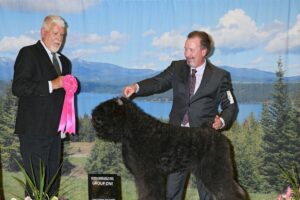
Interview With Breeder/Owner Handler Jim Anderson
Interview with a Breeder/Owner Handler Jim Anderson. Jim shares his experience in the world of purebred dogs and dog events.

Home » Dog Breeds » Bouvier des Flandres Dog Breed
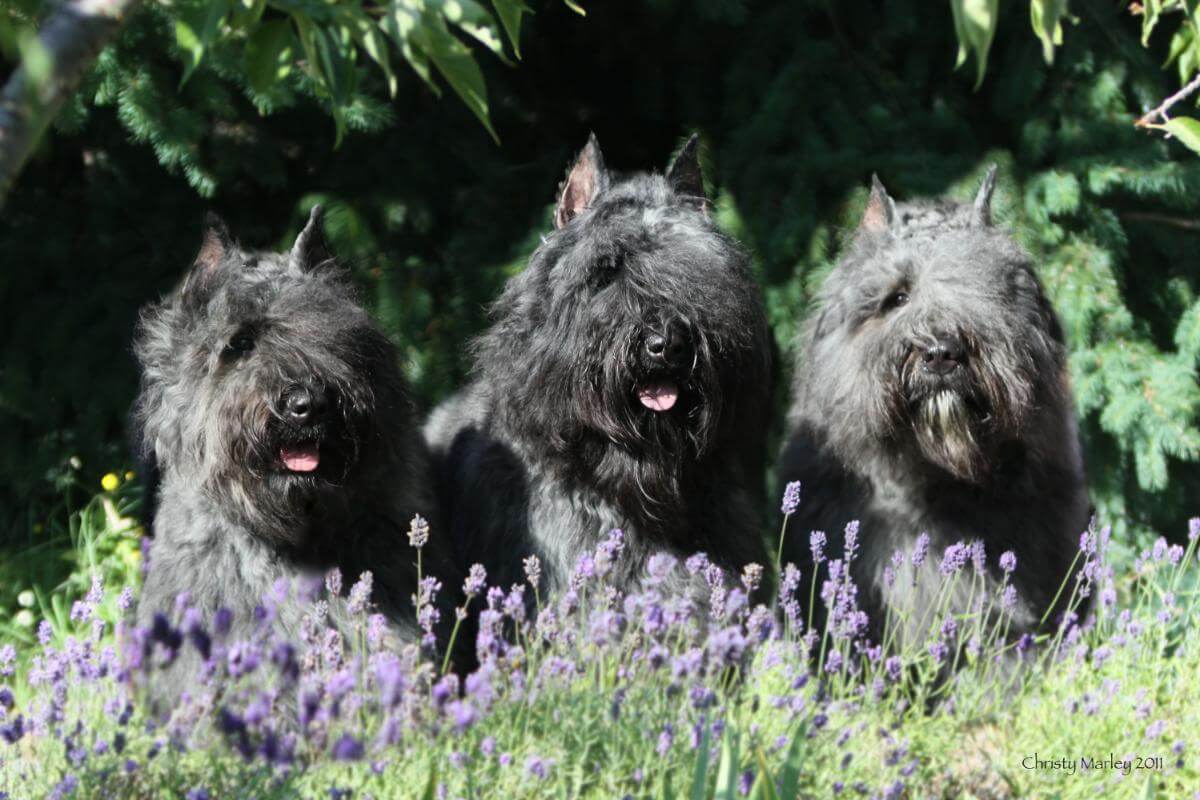
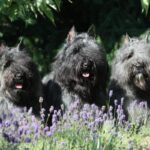
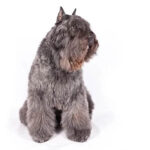
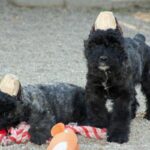
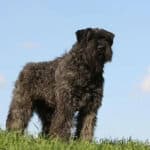
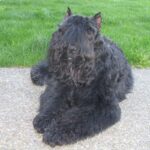
The Bouvier des Flandres, often simply referred to as the Bouvier, is a powerful and robust working farm dog known for its versatility in various tasks from herding to guarding. Originating from the Flanders region of Belgium, this breed is renowned for its loyalty, intelligence, and resilience.
Herding
23.5 – 27.5 inches
70 – 110 pounds
10 – 12 years
| Country of Origin | Belgium |
|---|---|
| Bred For | Herding, Guarding, Companionship |
| Known For | Rugged Appearance, Intelligence, Confidence, Protectiveness |
| Popularity | Moderate |
| Temperament | Courageous, Steady, Affectionate, Strong-willed |
| Activities | Herding, Hiking, Jogging, Farm Dog, , Search and Rescue, Conformation Shows, Dog Sports |
The Bouvier des Flandres is a breed steeped in history, originating from the Flanders region of Belgium. Its name translates to “Cow Herder of Flanders,” which provides a glimpse into the breed’s early role and purpose.
The Bouvier’s roots trace back to a time when the Flanders region encompassed parts of modern-day Belgium, France, and the Netherlands. In these rural settings, the breed was primarily used as a farm dog, responsible for various tasks from herding cattle and sheep to pulling carts. The dogs’ strength, intelligence, and protective nature made them invaluable assets on the farm.
Several breeds are believed to have contributed to the development of the Bouvier, the Brabant and possibly the Beauceron and the Dutch Griffon. Through the years, selective breeding has focused on refining the breed’s herding capabilities, strength, and protective instincts.
The late 19th and early 20th centuries saw the Bouvier’s popularity rise. The breed was used during the World War I for its strength and versatility, serving as an ambulance dog and messenger, and even used for pulling heavy machine guns. However, the war nearly brought the breed to extinction and the post-war era was particularly challenging. Thankfully, dedicated breeders worked tirelessly to revive the breed.
In the 1920s, a written Breed Standard for the Bouvier des Flandres was established in Belgium, further solidifying the characteristics and traits desirable in the breed. The era also saw the Bouvier’s introduction to other parts of the world, including the United States.
The American Kennel Club (AKC) recognized the Bouvier des Flandres in 1929. Since then, the breed has enjoyed steady popularity, not just as a working dog but also as a loyal companion and family pet. The Fédération Cynologique Internationale (FCI) and The Royal Kennel Club (UK) have also granted recognition, showcasing the breed’s appeal on the world stage.
The history of the Bouvier des Flandres is a testament to the breed’s resilience, versatility, and enduring appeal. From the farms of Flanders to households worldwide, the Bouvier’s journey is a story of survival, dedication, and the undeniable bond that is shared between humans and dogs everywhere.
The height of an adult male Bouvier des Flandres typically ranges from 24.5 to 27.5 inches tall at the shoulder, with mature females usually standing between 23.5 and 26.5 inches.
In terms of weight, adult Bouviers typically weigh between 70 and 110 pounds.
The Bouvier des Flandres boasts a harmonious and well-balanced structure. When viewed from the side, the length of the body, from the point of the shoulder to the point of the buttock, is equal to the height at the withers. This gives the Bouvier its distinct, compact appearance. In substance, the breed is powerful and solid, built for endurance and functionality. Its bone structure is hefty, yet its movement remains unhindered and fluid. This fluidity showcases the breed’s strength and agility alongside a proud carriage.
Texture: The Bouvier des Flandres boasts a double coat, which serves as protection against harsh weather conditions. The outer coat is rough, coarse, and dense, giving the breed its rugged appearance. Underneath, there’s a softer, fine undercoat which provides insulation. The harsh and tousled coat of the Bouvier features a heavy mustache and beard as well as the breed’s characteristic eyebrows. The coat is most often trimmed to a length of 2-1/2 inches, which still offers sufficient protection when the dog is working.
| Standard Color | |
|---|---|
| Black | ee |
| Brindle | ee |
| Fawn | ee |
| Gray Brindle | ee |
| Pepper & Salt | ee |
| Gray | ee |
| Black & Brown | ee |
| Black & Fawn | ee |
| Black & Gray | ee |
| White | ee |
| Black & White | ee |
| Brown | ee |
| Blue & Gray | ee |
| Blue | ee |
| Silver & Gray | ee |
| Black & Brindle | ee |
A Note About Color: The coat’s color ranges from fawn to black, with or without brindling or a black mask. White, brown, or parti-colored Bouviers are unacceptable.
| Standard Marking | |
|---|---|
| Brindle Markings | ee |
| White Markings | ee |
| Black Mask | ee |
The tail of the Bouvier des Flandres is set high on the rump and aligns with the spinal column. The tail is typically docked to a length that leaves 2-3 vertebrae, giving the hindquarters a balanced appearance when the dog is standing. Docking was historically done to prevent injury when the Bouvier was working or herding cattle, as a long tail was liable to get caught on brush or trampled by difficult livestock.
In places where tail docking is prohibited or has fallen out of favor, the Bouvier’s tail is left in its natural state. A natural tail is medium in length, reaching the hocks, and is carried either straight or with a slight upward curve. When the dog is in motion or alert, the tail may elevate but should never curl over the back.
The Bouvier des Flandres is not just a dog of striking appearance, it is also one of commendable intellect and loyalty. When considering bringing a Bouvier into the home, several factors come into play. The breed’s working lineage means these dogs have a natural inclination to be active and engaged. As with any purebred dog, understanding the breed’s specific needs and characteristics can make the experience of owning one of these dogs more rewarding.
The health of the Bouvier des Flandres is generally robust, owing to its origins as a working farm dog. The breed’s sturdy frame and dense coat are evidence of the resilience of this spirited dog. However, like all breeds and mixed breeds, the Bouvier can be prone to certain health conditions.
Lifespan: The average life expectancy of a Bouvier ranges between 10 and 12 years. This range can be influenced by factors such as genetics, diet, exercise, and regular veterinary care.
While the Bouvier des Flandres is generally a healthy breed, these dogs can be susceptible to certain health concerns, just like any dog. Awareness of these issues is key for owners to ensure the Bouvier remains in the best possible health.
Some of the health issues that can affect the Bouvier des Flandres include:
Routine check-ups with a veterinarian can help to detect and address issues early on. It’s also recommended for potential owners of Bouvier des Flandres to become familiar with the health screenings and tests available for the breed, and to consult with a reputable breeder for advice on prevention and treatment options.
The Bouvier des Flandres embodies intelligence, loyalty, and protective instincts, characteristics cultivated from their origins as herding and farm dogs. For novice or first-time dog owners, the Bouvier’s combination of loyalty and independent nature can be challenging. Consistent training and socialization from a young age are paramount, given the breed’s determined disposition. While these dogs exhibit an even temperament and show resilience, they do have a sensitivity that means abrupt changes in the environment or rough treatment can adversely affect their demeanor.
One trait which potential owners should be aware of is the Bouvier’s preference for the company. This breed thrives on human companionship and is not suited to long periods of solitude. Extended loneliness can result in the manifestation of undesirable behaviors, stemming from either boredom or anxiety.
Their relationships with other animals, including dogs, are generally amicable, especially if they have been raised together. However, the Bouvier does have a dominant streak that can surface when confronted with unfamiliar dogs. Early and consistent socialization can help to temper these instincts.
Within the household, especially when raised alongside them, the Bouvier des Flandres exhibits a gentle disposition towards children. The breed’s innate protective nature establishes these dogs as excellent family guardians. That said, due to their impressive size and strength, interactions with younger children should always be supervised.
When it comes to strangers, the Bouvier’s natural protective instincts come to the fore. The breed tends to be initially wary, evaluating the unfamiliar before deciding if it poses a threat. Over time, and with consistent introductions, these dogs can learn to distinguish between friendly visitors and those who might intend to do harm.
Feeding the Bouvier des Flandres requires a thoughtful understanding of the dog’s nutritional needs at various life stages. With roots tracing back to the rather flat terrain of Flanders, this robust breed demands a balanced diet to maintain its strength and vitality.
When considering the dietary needs of a Bouvier puppy, it’s essential to recognize that the pup’s growth phase requires a higher calorie intake, rich in proteins and essential nutrients, to support its developing bones, muscles, and immune system. Puppy-specific formulas are often recommended during the first year, as these are designed to meet these nutritional requirements.
As the Bouvier transitions to adulthood, its dietary needs evolve. Adult Bouviers, depending on their activity level, usually require a well-balanced diet that includes high-quality proteins, healthy fats, essential vitamins, and minerals. While many owners might be tempted to feed based on the dog’s size, it’s more appropriate to consider the dog’s age, weight, health, and activity level. On average, an adult Bouvier des Flandres might consume between 2.5 to 4 cups of high-quality dry dog food daily, divided into two meals. However, this can vary based on individual needs.
Regular monitoring of the Bouvier’s weight and body condition is crucial. Overfeeding can lead to obesity, which in turn can result in numerous health issues. On the other hand, underfeeding or providing an imbalanced diet can lead to nutrient deficiencies. It’s always advisable to consult with a veterinarian or a pet nutritionist to establish the best feeding regimen for the individual dog.
Water is another vital aspect of the Bouvier des Flandres’ diet. Ensuring the dog has access to fresh, clean water at all times is non-negotiable. It aids in digestion, helps to maintain body temperature, and supports overall metabolic functions.
Training a Bouvier des Flandres is an endeavor that rewards patience, consistency, and mutual respect. Boasting an impressive intelligence, this breed has an inherent desire to please its owner, but it also possesses a distinct independent streak that, if unchecked, can lead to stubbornness.
Starting the training process early is crucial with the Bouvier. The breed’s keen mind absorbs information rapidly during puppyhood, and this is the ideal time to lay the foundation for good behavior. Socialization is equally important at this stage. Exposure to various environments, people, and other animals will help to mold these pups into well-adjusted adults.
One noticeable trait of the Bouvier is its vocal nature. These dogs have a tendency to bark, especially if they sense something amiss in their surroundings. This protective instinct is commendable, but if left unchecked, it can become a nuisance. Therefore, training Bouviers to differentiate between ordinary occurrences and genuine threats can help in managing their vocal outbursts.
The Bouvier des Flandres is also known for its intelligence. While this makes these dogs apt learners, it also means they can quickly pick up undesirable behaviors if not guided correctly. Consistent training sessions, combined with positive reinforcement techniques, are most effective. Bouviers respond well to praise, treats, and play.
However, intelligence also brings with it the trait of curiosity. This breed can exhibit a degree of wanderlust. Hence, recall training becomes essential. Owners should ensure that their Bouvier is reliable in coming back when called, especially in open areas.
Despite the breed’s size and robust appearance, the Bouvier des Flandres does have a prey drive. This is a remnant of its days as a hard-working herder, when chasing was part of their everyday job. While it is less pronounced than in some breeds, it’s something an owner should be aware of, especially around smaller animals.
The Bouvier des Flandres is a breed that embodies a robust combination of strength, stamina, and endurance, reflecting the breed’s historical role as a farm dog and herder. Meeting the exercise needs of these dogs is crucial not just for their physical health but also for their mental overall well-being.
| Energy Level | Moderate to High |
|---|---|
| Exercise Requirements | 2 Hours/Day (Minimum), Daily Walks, Vigorous Running, Regular Exercise, Playing with Another Dog, Mental Stimulation |
Despite their sizable and somewhat imposing appearance, Bouviers possess a moderate to high energy level. This means they benefit significantly from regular and varied physical activities. A simple walk around the neighborhood might not suffice for this breed; these dogs thrive when engaged in more dynamic exercises like jogging, hiking, or playing fetch.
Given their herding instincts, Bouvier des Flandres often enjoy activities that simulate tasks or challenges. Engaging them in agility courses or herding exercises can be a great way to provide both mental and physical stimulation. They appreciate the challenge and the opportunity to work alongside their human partners.
The intensity of their exercise regimen should be consistent with their age and overall health. While younger Bouviers might have seemingly boundless energy, older dogs may prefer a more leisurely pace. It’s always essential to gauge the dog’s comfort and energy levels during physical activities.
Additionally, playfulness is a trait that shouldn’t be overlooked when discussing the Bouvier des Flandres’ exercise needs. This dog enjoy games and interactive toys, and these can be great tools for indoor exercise or for days when longer outdoor sessions aren’t feasible.
The Bouvier des Flandres, with its distinctive and dense double coat, requires diligent grooming to maintain its health and appearance. The rugged charm of the breed’s coat might give the impression of low maintenance, but in reality, regular care is essential to keep the Bouvier looking and feeling its best.
| Coat Type | Abundant, Tousled, Harsh |
|---|---|
| Grooming Requirements | Weekly Brushing, Occasional Bathing, Routine Ear Cleaning, Periodic Nail Trimming, Regular Tooth Brushing |
The Bouvier’s coat is relatively harsh to the touch, offering protection against harsh weather conditions. Beneath this outer coat lies a softer, insulating undercoat. Together, these layers act as a shield against both cold and wet environments. However, this protective coat can become a magnet for dirt, debris, and tangles if not regularly attended to.
Brushing is a fundamental aspect of grooming for the Bouvier des Flandres. A thorough brushing at least once a week helps to remove loose hairs, prevents matting, and distributes the natural oils across the coat, keeping it healthy and shiny. Due to the thickness of their coat, tools like a pin brush or a metal comb can be particularly effective.
Shedding in the Bouvier is not as pronounced as in some breeds, but this dog does shed moderately. Regular brushing not only manages this shedding, it also reduces the amount of hair and dander around the house.
While their coat doesn’t require frequent trimming, occasional trips to a professional groomer can be beneficial, especially for those Bouviers shown in Conformation events. These grooming sessions can help to shape the coat, maintain cleanliness, and address any specific needs like ear cleaning or nail trimming.
Bathing a Bouvier des Flandres doesn’t need to be a frequent affair. Due to the nature of the breed’s coat, overbathing can strip essential oils and result in a dry, brittle texture. Instead, baths should be given as needed, based on the dog’s activity and the level of dirt accumulated.
Living with a Bouvier des Flandres is an enriching experience, filled with loyalty, protection, and companionship. However, understanding the breed’s unique characteristics and needs is essential to create a harmonious living environment.
First and foremost, while the Bouvier des Flandres can adapt to various living conditions, these dogs thrive in spaces where they have room to move. Though they can adjust to apartment living, especially if their exercise needs are diligently met, a home with a yard where they can play and patrol is ideal.
Given their historical role as farm dogs and protectors of livestock, the Bouvier possesses a natural protective instinct. This means they can be wary of strangers and will often stand guard over their home and family. Proper socialization can help to balance this protective nature, ensuring the Bouvier is discerning rather than overly aggressive.
When it comes to weather tolerance, the Bouvier’s dense double coat provides insulation against colder climates. They are well-equipped to handle chilly conditions and can enjoy outdoor activities even in the winter months. On the flip side, their thick coat can be a disadvantage in hot weather. In warmer climates or during the peak summer months, it’s important to ensure the Bouvier has a cool, shaded place to retreat to and that exercise is scheduled during the cooler parts of the day.
The Bouvier des Flandres’ strong bond with its family also means these dogs prefer to be involved in household activities. While they can handle being alone for short periods, prolonged isolation can lead to feelings of anxiety or boredom. Integrating them into daily routines, whether it’s a walk in the park or a quiet evening in the living room, ensures they feel connected and content.
The arrival of a Bouvier des Flandres puppy into a household is an exciting time, brimming with potential and new beginnings. These puppies, with their adorable expressions and boundless energy, soon grow into the strong and loyal dogs that the breed is known to be. Understanding the developmental and care needs of Bouvier puppies is critical to ensuring they grow up to become healthy and well-adjusted adults.
Caring for a Bouvier des Flandres puppy is a multifaceted responsibility that encompasses nutrition, health, socialization, and training. From the moment they are brought home, a structured and loving environment is essential for their well-being.
Nutrition plays a pivotal role during the puppy phase. Providing high-quality, balanced puppy food guarantees they receive the essential nutrients for growth and development. It’s advisable to consult with a veterinarian or breeder for specific feeding guidelines tailored to the Bouvier puppy’s needs.
Regular veterinary check-ups during the puppy phase are crucial. These visits not only monitor the puppy’s health and development but also set the schedule for vaccinations and other preventative care measures. Keeping a close eye on a puppy’s health in these early stages can prevent potential issues down the road.
Socialization is another critical component of care for Bouvier puppies. Introducing pupppies to various environments, people, and other animals in a controlled and positive manner helps to shape their temperament. Positive encounters during their formative weeks and months play a significant role in how they interact with the world as adults.
Training, too, should begin early. Bouviers are intelligent and eager to learn, and starting with basic obedience commands provides a foundation for more advanced training later on. Consistency, patience, and positive reinforcement are keys to successful training sessions.
Lastly, the bond formed between the puppy and its family during these early months is profound. Spending quality time with the Bouvier puppy, whether through play, training, or simple companionship, strengthens this bond and sets the tone for a lifelong relationship.
The Bouvier des Flandres, with its strong physique and sharp intellect, is naturally inclined towards activities and dog sports. These endeavors not only provide physical stimulation, they also cater to the breed’s mental agility and need for challenges. Engaging in activities and dog sports can strengthen the bond between the dog and its handler, offering mutual enjoyment and fulfillment.
Engaging a Bouvier des Flandres in these activities and dog sports can offer numerous benefits. Beyond the physical exercise and mental stimulation, participation fosters a deeper connection between dog and handler. For the Bouvier, the opportunity to engage in tasks, challenges, and structured play taps into the dog’s natural instincts and provides an enriching experience.
The Bouvier des Flandres is recognized by the world’s leading registries and kennel organizations, which categorize the breed into a specific Group based on its unique characteristics. This breed is recognized worldwide under the following Group designations:
| Organization | Group Designation |
|---|---|
| AKC (American Kennel Club) | Herding |
| UKC (United Kennel Club) | Herding Dog |
| CKC (Canadian Kennel Club) | Herding |
| ANKC (Australian National Kennel Council) | Working Dogs |
| RKC (The Royal Kennel Club) | Pastoral |
| FCI (Fédération Cynologique Internationale) | Group 1: Sheepdogs and Cattledogs Section 2: Cattledogs |
The ideal Bouvier des Flandres is described by a Breed Standard that is approved by each of the world’s leading registries and kennel organizations. The Breed Standards for this breed may be found in the following links:
| Organization | Breed Standard |
|---|---|
| American Kennel Club | AKC Bouvier des Flandres Breed Standard |
| United Kennel Club | UKC Bouvier des Flandres Breed Standard |
| Canadian Kennel Club | CKC Bouvier des Flandres Breed Standard |
| Australian National Kennel Council | ANKC Bouvier des Flandres Breed Standard |
| The Royal Kennel Club | RKC Bouvier des Flandres Breed Standard |
| Fédération Cynologique Internationale | FCI Bouvier des Flandres Breed Standard |
Breed clubs play a pivotal role in the preservation, education, and promotion of specific dog breeds. For the Bouvier des Flandres, various clubs worldwide are dedicated to ensuring the breed’s well-being and the continuation of its storied legacy.
In the United States, the American Bouvier des Flandres Club (ABdFC) stands as the official “parent” organization for the breed. Established in 1963, the ABdFC focuses on promoting responsible breeding, facilitating breed education, and organizing events that showcase the many talents of the Bouvier.
In the United Kingdom, the Bouvier des Flandres Club of Great Britain champions the breed. This club, with its rich history, endeavors to provide resources, education, and events for Bouvier owners and enthusiasts throughout the UK.
Membership or association with these clubs offers numerous benefits for Bouvier owners. Not only do they provide access to a community of like-minded enthusiasts, they also offer resources, workshops, and events tailored to the breed and its supporters.
Rescue organizations play an indispensable role in the canine world. For the Bouvier des Flandres, these groups provide a safety net for dogs in need, offering them a second chance at a loving home. They are committed to rescuing, rehabilitating, and rehoming Bouviers that have been abandoned, mistreated, or are simply in need of a new family.
In the United States, the American Bouvier Rescue League (ABRL) is at the forefront of these efforts. Dedicated to the Bouvier des Flandres, the ABRL works tirelessly to find suitable forever homes for Bouviers in need. The group’s volunteers not only offer adoption services, they also engage in public education about the breed and responsible ownership.
Canada has rescue groups such as the Bouvier Rescue of Ontario. This group focuses on rescuing and rehoming Bouviers within the Ontario region. This volunteer-led organization works closely with foster homes and potential adopters to ensure the best possible outcomes for the dogs they rescue.
In the United Kingdom, the Bouvier des Flandres Welfare & Rescue UK emerges as a significant force for the breed. This group, established by dedicated breed enthusiasts, works diligently to rescue and rehome Bouviers in the UK. The group also engages in raising awareness about the breed’s needs and offers support to Bouvier owners.
Yes, Bouvier des Flandres shed, but their shedding is relatively minimal compared to some other breeds. Their thick, coarse double coat helps to trap dead hair, reducing the amount found around the house. Regular grooming, including brushing and occasional trimming, can further reduce shedding and maintain the coat’s overall health.
Bouvier des Flandres are not known to be excessive barkers. However, they are alert and protective, so they may bark to alert their owners of strangers or unusual occurrences. Training from a young age and providing them with ample mental and physical stimulation can help to control unnecessary barking.
On average, the Bouvier des Flandres has a lifespan of 10 to 12 years. With proper care, regular vet check-ups, and a balanced diet, some Bouviers can live even longer. Their longevity can be influenced by genetics, health care, and their general living conditions.
While no dog is truly hypoallergenic, the Bouvier des Flandres is often considered a good choice for allergy sufferers due to their low shedding coat. Regular grooming can help to reduce dander, which is often the primary cause of pet-related allergies. However, potential owners with allergies should spend time with this breed before committing.
“Bouvier des Flandres” is a French term that translates to “cowherd (or cattle driver) from Flanders.” The name reflects the breed’s origin in the Flanders region of Belgium and their historical role as a cattle herding farm dog.
Bouvier des Flandres are protective and can be wary of strangers, but they are not inherently aggressive. Proper socialization from a young age is essential to ensure they become well-adjusted and balanced as adults. Any signs of aggressive behavior should be addressed with training and, if necessary, consultation with a canine behavioral specialist familiar with the breed.
Yes, Bouvier des Flandres can make excellent family dogs. They are loyal, and affectionate, and often form strong bonds with their family members. Their protective nature makes them great watchdogs, but they are typically gentle with children and people with whom they are familiar. As with all dogs, early socialization and training are crucial for maintaining a harmonious household.
Bouvier des Flandres are not known to be excessive droolers, like some other breeds. However, they may drool in anticipation of food, during physical exertion, or when they’re especially warm. Regularly checking and cleaning of their beards can help to keep any drooling or dampness under control.

Interview with a Breeder/Owner Handler Jim Anderson. Jim shares his experience in the world of purebred dogs and dog events.
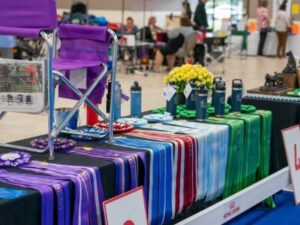
Celebrating 60 years of the American Bouvier des Flandres Club! Join us for events, awards, and the joy of our beloved breed.

Experienced Bouvier des Flandres breeder Debra Gschwender reflects on breed changes, show challenges, and mentoring in the dog community
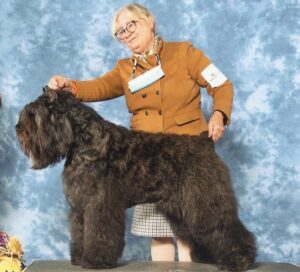
Insights from an Owner Handler, Jeannette Nieder. Read about her opinions on various topics about dog handling in the modern show ring.
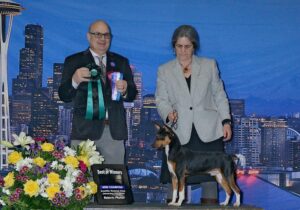
Cory Downey Hart is the breeder behind DHart Rat Terriers & Bouviers. Read about the kennel’s beginnings, dogs, puppies, photos and more!
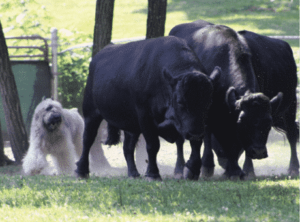
Bouvier des Flandres: A Farmer’s Dog | Let’s take a trip back in time. Let’s go back well over a hundred years to the country of Belgium
The best way to ensure a long and happy relationship with a purebred dog is to purchase one from a responsible breeder. Not sure where to begin?
Contact the National Parent Club’s Breeder Referral Program, which is listed on the AKC Breeder Referral Contacts page.
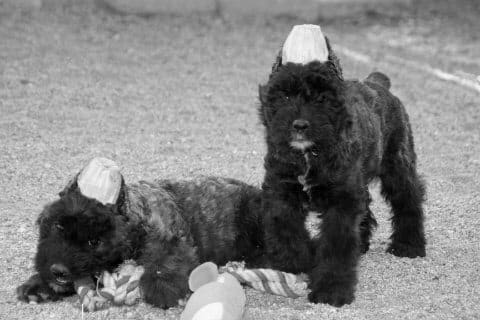

"*" indicates required fields
Showsight Magazine–the world’s most influential purebred dog publication since 1992. Each issue reaches a global audience dedicated to preserving the history and health of purpose bred dogs. Filled with award-winning editorial focused on news and insights from the dog show community, top breeders, handlers, AKC Judges, and more!